Visit our online store for 100% handmade items!

Begonias are a showstopper in many summer gardens. But, they are no match for rapidly falling temperatures. In northern zones, these plants are prone to frost damage and death unless they are protected.
In today’s blog, we introduce you to the history and different types of begonias. We also walk you through the steps to successfully overwinter begonias indoors. We even give you some basic winter care tips to support your begonias indoors during their winter dormancy. By following the tips and tricks in today’s blog, you will be well on your way to knowing how to save your begonias for next year.
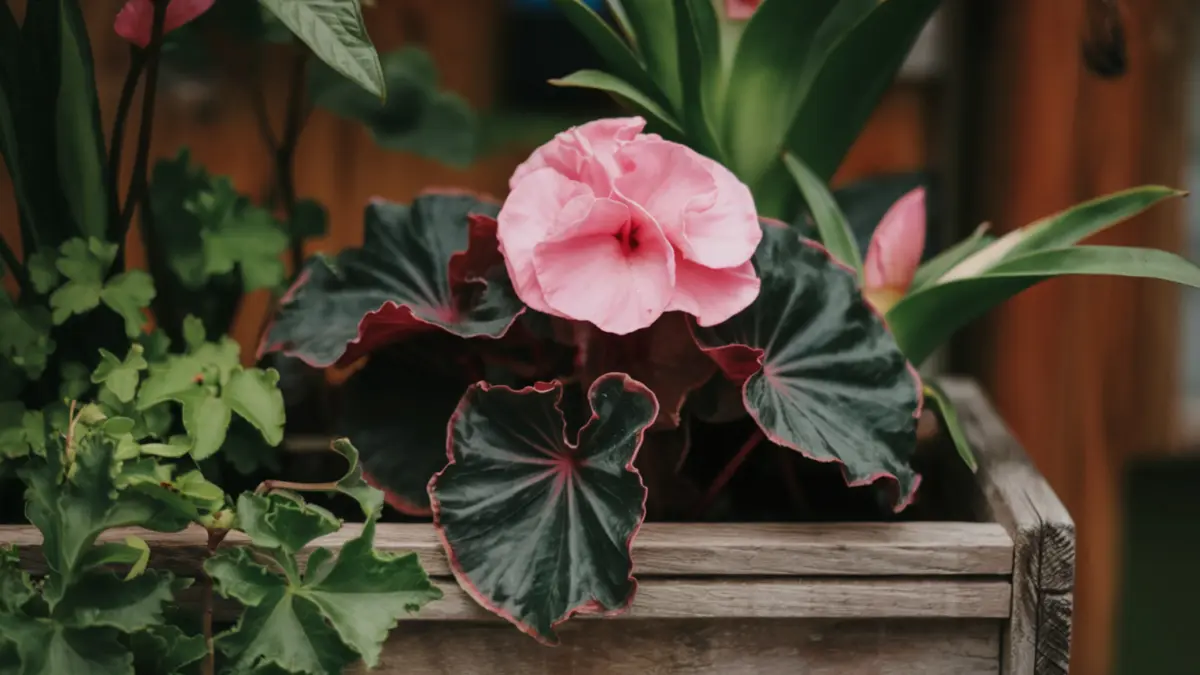
A brief history of begonias
Begonias are native to the tropics and subtropics. They grow in a variety of different conditions, terrains, and altitudes.
Begonias started to arrive in Europe from overseas in the mid 19th century. Their introduction took Europeans by storm and they gained increasing popularity among the Victorians.
Their arrival to North America came much later. In the 1920s and 1930s, begonia fever in America had taken hold. In fact, it was in 1932 that the American Begonia Society was formed. Today, many of the varieties available to North Americans come through seed exchanges. They are also shared through propagation and cultivation.
The newest trend in begonias has been the development of cold tolerant varieties. The begonia with the highest tolerance for cold is Begonia grandis. This begonia can withstand temperature plunges to 14 degrees Fahrenheit or -10 degrees Celsius.
Others begonia varieties like B. formasana, B. pedatifida, and B. emeiensis are winter hardy in the Pacific Northwest and Carolinas. Due to their mild winter hardiness, they may also be able to thrive in similar environments.
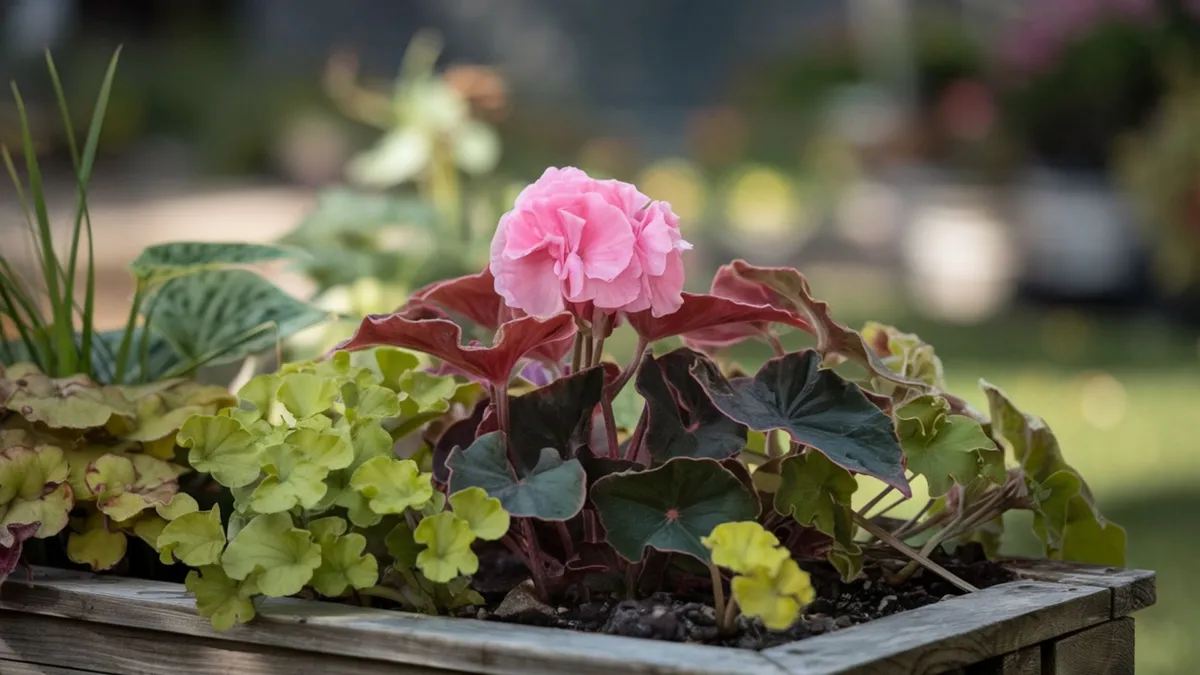
Why should you grow begonias?
Begonias are loved by generations of gardeners. They are relatively easy to grow and care for. They also come in a wide variety of different cultivars. A small collection can produce flowers year round.
Begonias have a striking beauty. They were once the pride of many Victorian era gardens. They are also equally popular in Japanese themed gardens.
Begonias are versatile plants when used in the garden. They are grown for their unique leaves and foliage. Or, they are grown for their whimsical blooms.
By growing, propagating, and sharing different varieties with other gardeners, its helps to keep different varieties of begonias growing strong for generations.
What are some different types of begonias?
In general, begonias are easy to hybridize. In the modern era, this has lead to the development of many fun and interesting cultivars. Hybrids come and go as the fashion and tastes of gardeners change. But, many of the original varieties remain old standbys.
Early varieties such as ‘Ricinifolia’, ‘Erythrophylla’, and ‘Phyllomaniaca’ are still grown today. These varieties are often passed down by gardeners. This has led to their permanent place in many of today’s modern gardens.
There are four main types of begonias:
- Fibrous-rooted: Some common types of begonias in the category include wax begonias, cane begonias, and dragon-wing begonias. These begonias have a root ball with shallow, thin roots. Their flowers are smaller than other varieties.
- Tuberous: These begonias form tubers underground similar in growth pattern to a potato. Sprouts form from the tuber. They have large flowers in neon shades including pink, yellow, orange, red, and white. Tuberous begonias are popular for flower beds or when grown in containers.
- Hardy: Hardy begonias are often grown as a perennial in zones 6-9. They can withstand colder temperatures and adapt to these conditions. Their leaves are like tuberous begonias, but their flowers are much smaller in shades of white and pink.
- Rhizomatous: These begonias form rhizomes underground along which new growth grows horizontally. Rhizomatous begonias are mainly grown for their colourful foliage. They are often grown as houseplants rather than outdoor bedding plants.
Basic care tips for begonias
Each variety of begonia that you grow will have its own unique set of care tips. However, there are a few basic conditions that each variety needs to survive.
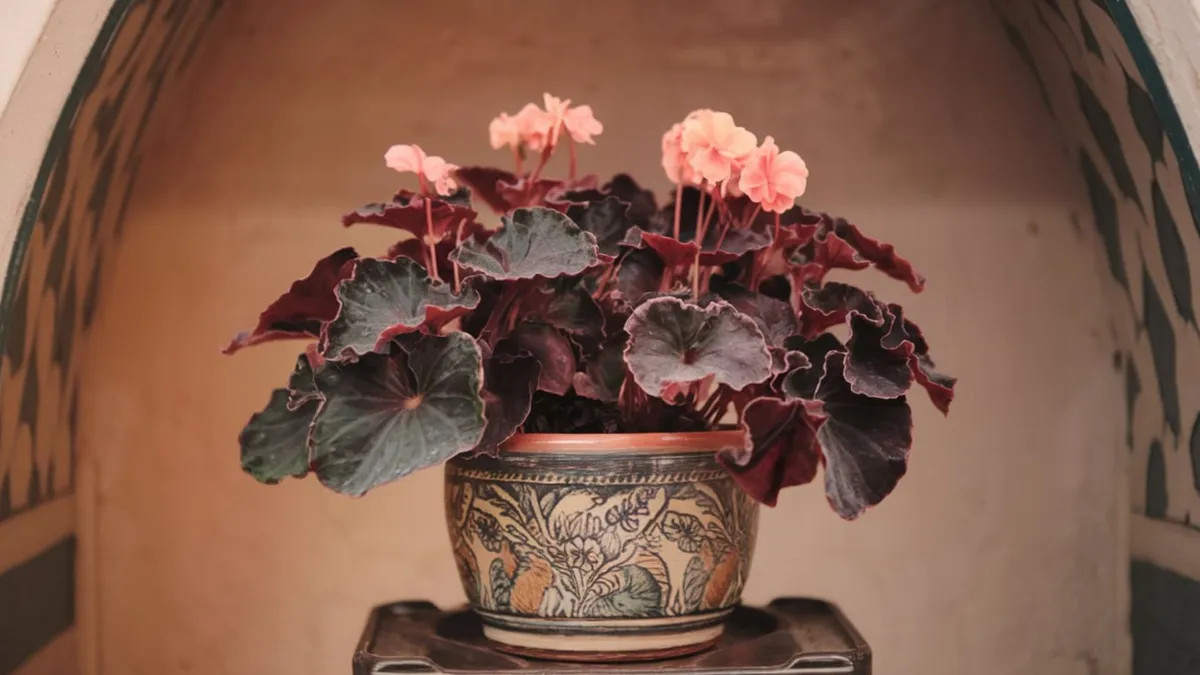
Temperature
Begonias need the right balance of temperature, light, and humidity. Most begonias are highly adaptable. This makes it easy to combine different varieties in the same growing conditions.
Most begonias prefer temperatures in the range of 55 to 85 degrees Fahrenheit. Nighttime temperatures should be lower than the average daytime temperatures.
Begonias which naturally grow in high elevations will require temperatures on the lower end. While, those that grow in lower elevations will require higher temperatures.
In a greenhouse, you can easily lower the daytime temperatures by using wet pads. You can also douse the floor of the greenhouse in ice-cold water. Be sure to do this in the morning. The ice-cold water will help lower the indoor daytime temperature.
Light
Many varieties of begonias require well lit conditions to grow. However, the amount of light they require depends on the area that they are growing in. Some shading may be necessary to avoid scorching.
If grown indoors, a south-facing windowsill is best during the winter. Place in an east-facing window in the summer.
Sometimes your plant might be ailing and it could be a problem with the amount of light it is receiving. It can often be difficult to tell if this is the case. There are a few signs to watch for. If your begonia is receiving too little light, will have foliage that is pale. The leaves may also appear leggy.
If your plant is receiving too much light, the leaves may appear dry or burnt around the edges.
The stems and leaves of certain varieties may also appear purple or red if they are getting too much light. If lighting is the problem, moving it to new conditions should allow the plant to recover. It will need monitoring until the plant recovers.
Humidity
Most begonias require humidity levels between 40 to 60 percent. If a begonia does not have the right humidity levels, the leaves will turn brown and become too crispy.
In more extreme conditions, the leaves may fall off and flowers may drop. To increase humidity, you can use humidity trays with pebbles. You simply add water to the tray and the plant sits on top of the peddles, not directly in the water. The plant will reap the benefits as the water vapor rises.
If conditions are too humid, it can lead to the growth of fungal and bacterial diseases. One such condition is leaf rot. If growing in the home, install fans to help circulate the air. It may be necessary to install proper ventilation in a greenhouse to reduce the levels of humidity.
Choosing the proper container and growing medium
Begonias have quite shallow roots. Therefore, they often need a shallow container to grow in. There are a few varieties that have more cane-like, taller growth. These varieties will need a taller container or else they will become too top heavy.
For northern growers, growing begonias in containers can sometimes lead to too much moisture. Consider more porous containers like clay pots. Southern growers will often use plastic pots to keep moisture in.
Most begonias will need to be repotted once their roots reach the sides of the container. Choose a container that is only slightly bigger than where the roots stop. That way, water will not build up on the edges. You want to avoid root rot.
The best growing medium for most begonias is slightly acidic, loose, and well draining. You can buy a premade soilless mixture. Or, you can make your own mix. You can also add coarse sand, bark or perlite to help improve drainage. This will also help to increase air circulation around the roots.
Water
The amount of water that your begonia needs will depend on several factors. These are the climate, the growing medium, and the type of container. Most begonias grown in pots will need water when the top half inch of soil becomes dry. Overwatering and the improper balance of humidity are two areas to watch out for.
When watering begonias, be extra careful with rhizomatous, rex, and tuberous begonias, especially during dormancy.
Common symptoms of overwatering are leaf drop, root rot, or stems that are wilting. Wilting can also be a sign that a plant is underwatered. You may also see yellowing leaves and flower buds that fall off before opening.
Keeping a regular watering schedule will help your begonias to stay healthy and strong.
Fertilizing
When begonias are actively growing, you can apply a water-soluble fertilizer. A ratio of 20-10-20 is best. Be sure to read the directions first before applying. Too much fertilizer can burn the roots of most plants.
Avoid fertilizing newly repotted begonias for a least a month. Do not apply fertilizer to a sickly or damaged plant.
Begonias grown in soilless growing mediums will require a greater level of fertilizer. Some gardeners prefer to use slow-release granular fertilizers. It really just depends on your preference. You may need to experiment a bit to find the best solution that works for you.
Common pests and diseases
There are a few common pests which can wreak havoc with begonias:
- Mealy bugs
- Mites
- Nematodes
- Scale Insects
- Slugs and snails
- Weevils
- Whiteflies
There are a few common diseases which can cause problems for begonias:
- Bacterial leaf spot
- Blight
- Powdery Mildew
- Root rot
- Crown rot
- Viral diseases
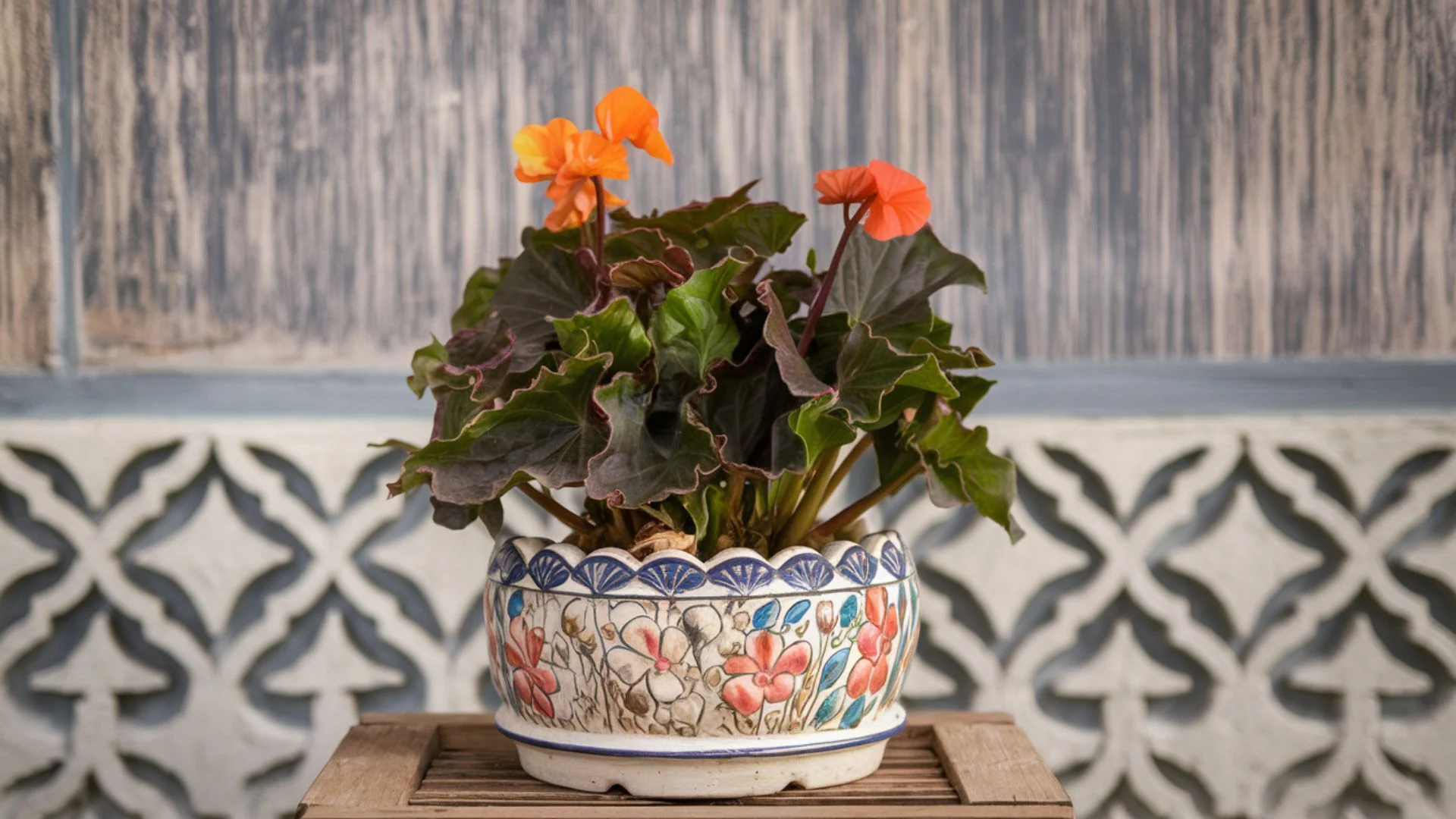
When is the best time to bring begonias indoors to overwinter?
The best time to bring your begonias indoors is in early fall. This is when they are starting to wind down their production.
For more tender varieties of begonias, this process should be started well before your first hard freeze of the year. Frost can cause significant damage to the leaves and stems. Keep an eye on the weather during this time. It will help you determine when is the best time to move your plants indoors.
How to successfully overwinter three types of begonias indoors: A step-by-step guide
The first step to overwintering your begonias is determining which type you have. Some more tender varieties can become a beautiful houseplant indoors. Others will benefit from being allowed to die back first before storing them indoors over winter.
In general, there are four main types of begonias which include:
- Fibrous-rooted
- Tuberous
- Hardy
- Rhizomatous
Overwintering fibrous-rooted and rhizomatous begonias indoors
Fibrous-rooted begonias, like wax begonias, are one of the varieties that can go directly indoors. Here, they become a beautiful houseplant to enjoy over the winter.
These plants are frost tender. You will need to move them indoors quite quickly once the temperatures start to drop. Certainly if there is a risk of frost is in the forecast.
If you planted them in the ground, you can easily remove them and repot into some new potting mix. When choosing a potting mix, look for one that is rich in nutrients and has good drainage.
Rhizomatous begonias can also be brought indoors over winter. They grow best in pots. They can live indoors over winter as a houseplant. Once inside, they will shed some of their foliage. But, with proper care and attention indoors, they will once again put on new growth.
Both fibrous-rooted and rhizomatous begonias will benefit from proper light, moisture, and humidity control. Actively monitor their progress indoors and adjust these conditions as needed.
Tuberous begonias
Much like a dahlia tuber, you will need to dig up the begonia tubers and store them properly indoors. This is necessary if you live in a zone with freezing temperatures. You must dig up your tubers and properly store them indoors before the first frost and temperatures begin to fall.
For best results, dig up your tubers with a garden fork. Try to stay out from the tubers by a least a foot to avoid damaging them or cutting into them.
After you have removed the tubers from the soil, gently shake off any loose dirt from them. Allow the tubers to dry out a bit in dry air over a few days. Once dried, store in a cool, dark and dry place indoors.
To store your tuberous begonias, you can put them in a cardboard box with either wood shavings or perlite. This will keep them dry. Be sure to keep an active eye on them while in storage.
How to overwinter begonias in Canada?
Overwintering begonias in Canada is easy. You simply follow the same process as other areas with freezing temperatures and frost. For tuberous begonias, remove from the garden before your last frost.
Both fibrous-rooted and rhizomatous begonias can be brought indoors over the winter in Canada too.
Always be sure to inspect your plants once they come indoors. Repot into new soil.
Give your begonias bright, indirect light and a semi-warm location in your home. A windowsill or area with filtered light will do just fine. Keep an eye on their water level indoors. They should be moist, but not soaked.
Overwintering begonias outdoors in southern growing zones
In more southerly growing zones, begonias can often be overwintered outdoors. These areas would be ones where frost is rare. In these zones, begonias will go dormant, but will come back when temperatures warm up more.
As temperatures fall above freezing, the begonias will enter dormancy on their own. Once this happens, feel free to trim back any dead foliage to the ground. Once they exit dormancy, your begonias will come back stronger and healthier.
Winter prep: Inspecting and protecting begonias indoors
When bringing plants indoors, inspect for any insects or signs of disease. There are many different sprays for your indoor plants to control pest pressure and diseases. Each gardener has a preference that works for them. Feel free to use what works best for you.
Helping begonias adjust to indoor life
When you bring your begonias indoors, they may undergo some stress. This is due to adjusting to their new home inside your house.
Signs of stress could include leaves drooping or dropping off.
One way to help your plant adjust to indoor growing conditions is to place it into a more shady part of your yard that gets partial sun. Do this for about a week or two before bringing them indoors. By exposing the plants to filtered light outdoors, it will help them to adjust to the reduced light indoors.
Once indoors, find an area of your home that gets adequate light. This could be a windowsill or under grow lights. Here, you can mimic some of the outdoors conditions these plants were used to outdoors.
Make sure that your begonias stay moist, but not soaked. Keep on eye on their water levels weekly. Make sure that they are never sitting in standing water. Sitting in standing water can lead to rot.
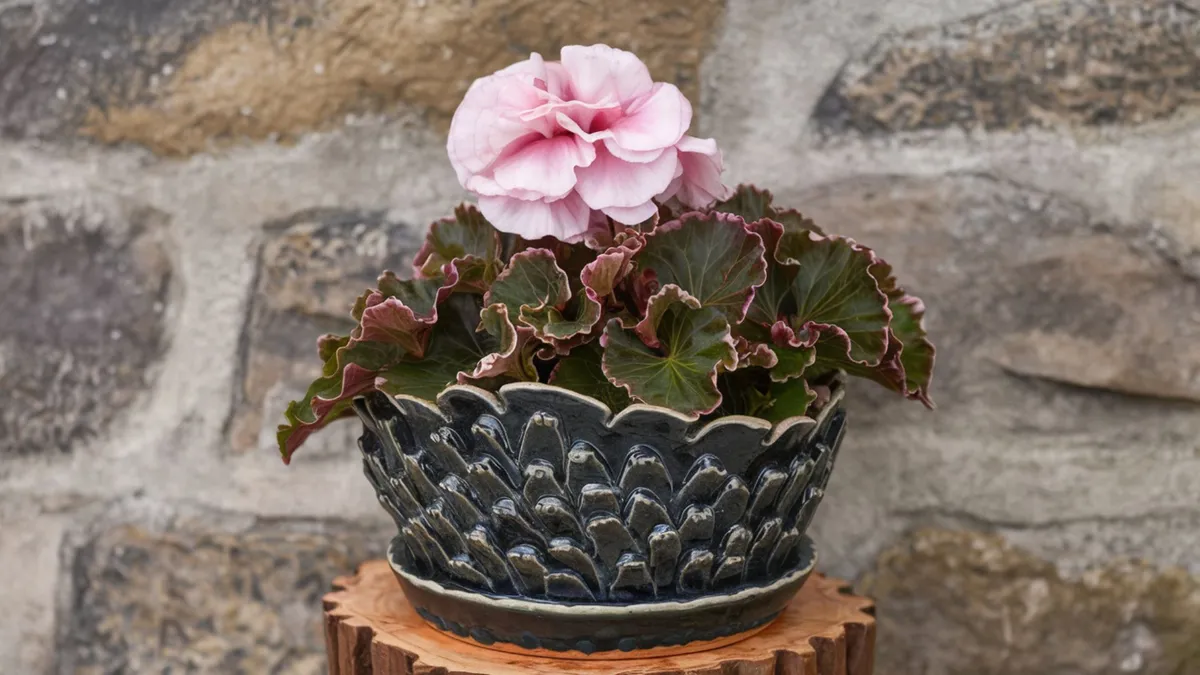
Frequently asked questions
Can I leave my begonias in pots over winter?
Yes you can. If you live in an area with freezing temperatures and frost, bring them indoors before temperatures fall. Both fibrous-rooted and rhizomatous begonias can be successfully overwintered in pots indoors. Give them the right light, water, and temperature conditions.
Can you overwinter begonias in pots in a garage?
Yes, you can overwinter begonias in a garage. After you trim them back a bit, you can keep them in a frost free cellar or garage. This will give them extra added protection from the elements.
Starting in early spring after danger of frost has passed, you can slowly wake them up. Gently transition them outdoors to re-start the growing cycle. Take your time and don’t rush the process.
How do you tell if a begonia is tuberous?
Tuberous begonias often come in single or double petals. Their leaves are oval shaped and about 8-10 inches long. The blooms are often frilly and come in a variety of colours.
Final thoughts on caring for begonias indoors
Growing begonias is truly the highlight of the gardening season for many growers. But, for those in colder climates, come winter, you will need to take some extra steps to preserve these beautiful plants.
By following the steps and tips in today’s blog, you will be well on your way to successfully overwintering begonias indoors.
For more great tips, be sure to follow us on Facebook, Instagram, and Pinterest. While you are there, consider subscribing to our newsletter so that you don’t miss out on any of the latest updates from all of us here at Bluenose Blooms.




Overwintering begonias indoors is a game-changer! I used to treat mine as annuals until I learned how to keep them going. What’s your favorite plant to bring inside for the winter?